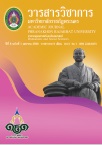ศึกษาแนวทางการเลือกตั้งนายกรัฐมนตรี โดยตรงของประเทศไทย
Keywords:
การเลือกตั้งนายกรัฐมนตรีโดยตรง Direct Prime Minister ElectingAbstract
การวิจัยเรื่องนี้ ศึกษาแนวทางการเลือกตั้งนายกรัฐมนตรีโดยตรงของประเทศไทย มีวัตถุประสงค์การศึกษา 1) เพื่อศึกษาระบบการเลือกตั้งของประเทศไทยในปัจจุบัน 2) เพื่อศึกษาแนวคิด รูปแบบ และวิธีการเลือกตั้งนายกรัฐมนตรีโดยตรงของประเทศไทย และ 3) เพื่อแสนอแนวทางการเลือกตั้งนายกรัฐมนตรีโดยตรงของประเทศไทย การวิจัยครั้งนี้เป็นการวิจัยเชิงคุณภาพให้ความสำคัญกับปัจจัยด้านโลกทัศน์ วัฒนธรรม ความคิด ความเชื่อทางการเมือง เนื่องจากการศึกษาทางรัฐศาสตร์เป็นการศึกษาเกี่ยวกับความคิดทางการเมืองให้เกิดความลึกซึ้ง ดังนีั้นจึงเน้นหนักไปที่การใช้ข้อมูลจากเอกสาร และวิเคราะห์ข้อมูลด้วยวิธีการตีความและนำไปสู่การสร้าง "ข้อสรุปทั่วไป" ผลการศึกษาพบว่า 1.องค์ความรู้เกี่ยวกับระบบการเลือกตั้งของประเทศไทยในปัจจุบัน ระบบการเลือกตั้งเป็นรากฐานสำคัญของประเทศ โดยมีรากฐานแนวคิดมาจากการยินยอมของคนในสังคมที่สละอำนาจของตนเองเพื่อให้คณะบุคคลที่ถูกประชาชนเลือกเข้าไปทำหน้าที่แทนตนในการบริหารราชการแผ่นดิน ปัจจุบันประเทศไทยใช้ระบบการเลือกตั้งแบบผสม (Mixed System) กล่าวคือ เป็นระบบการเลือกตั้งที่พยายามนำเอาข้อดีของระบบการเลือกตั้งแบบเสียงข้างมากธรรมดา เสียงข้างมากเด็ดขาด และระบบสัดส่วนมาใช้ โดยในการเลือกตั้งแต่ละครั้งจะนำ 2 ระบบมาใช้ร่วมกัน ระบบการเลือกตัั้งแบบผสมแบ่งออกเป็นระบบผสมเขตกับสัดส่วน (Mixed Member Proportional System) และระบบคู่ขนานระหว่างเขตกับสัดส่วน (Parallel System) ระบบการเลือกตั้งของประเทศไทยได้มีการปรับเปลี่ยน พัฒนารูปแบบและวิธีการเพื่อให้มีความเหมาะสมกับสภาวการณ์ซึ่งขึ้นอยู่กับสภาพแวดล้อมทางการเมือง เศรษฐกิจ และสังคมในแต่ละยุค นับตั้งแต่การเลือกตั้งครั้งแรกเมื่อวันที่ 15 พฤศจิกายน พ.ศ. 2476 ซึ่งเป็นการเลือกตั้งครั้งแรกของประเทศไทยภายหลังการเปลี่ยนแปลงการปกครองระบอบสมบูรณาญาสิทธิราชย์มาเป็นระบอบประชาธิปไตย ใช้วิธีการเลือกตั้งโดยวิธีทางอ้อม ซึ่งเป็นครั้งเดียวของประเทศไทย นอกจากนั้นเป็นการเลือกตั้งโดยตรงทั้งหมด มีทั้งแบ่งเขต รวมเขต แบบผสมรวมของเขตกับแบ่งเขตการกำหนดจำนวนสมาชิกผู้แทนราษฎรใช้จำนวนประชากรเป็นเกณฑ์ในการคำนวณ ถึงแม้ได้มีความพยายามในการปรับเปลี่ยนพัฒนา รูปแบบและวิธีการเลือกตั้งเพื่อให้มีความเหมาะสมหลายครั้งจนกระทั่งปัจจุบัน แต่ก็ยังไม่ได้รับคำตอบที่ชัดเจนว่าวิธีการเลือกตั้งแบบใดมีความเหมาะสมกับประเทศไทยมากที่สุด และเชื่อได้ว่าจะมีการปรับปรุง เปลี่ยนแปลงเพื่อให้มีความเหมาะสมยิ่งขึ้นในอนาคตต่อไป 2.แนวคิดเกี่ยวกับการเลือกตั้งนายกรัฐมนตรีโดยตรงของประเทศไทย การเลือกตั้งนายกรัฐมนตรีโดยตรง เป็นแนวทางหนึ่งในการพัฒนาระบบการเมืองให้มี "ความเป็นสถาบัน" อันจะทำให้ระบบการเมืองสามารถตอบสนองความต้องการของประชาชนได้อย่างมีประสิทธิภาพและประสิทธิผล และจะทำให้รัฐบาลมีเสถียรภาพทางการเมืองยิ่งขึ้น ประเทศไทยถึงแม้เป็นประเทศที่ปกครองในระบอบประชาธิปไตยอันมีพระมหากษัตริย์ทรงเป็นประมุข การที่จะให้มีการเลือกตั้งนายกรัฐมนตรีโดยตรงสามารถทำได้โดยมีการจัดความสัมพันธ์ระหว่างสถาบันหลักของประเทศและระบบต่างๆ ที่เีกี่ยวข้องให้มีการประสานสัมพันธ์กันและส่งเสริมกันและกัน การเลือกตั้งนายกรัฐมนตรีโดยตรงจะเป็นผลดีต่อประชาชนหลายประการ เช่น ประชาชนได้เลือกผู้ที่มีความรู้ความสามารถที่เหมาะสมมาเป็นนายกรัฐมนตรีและเป็นการสกัดกั้นคนไม่ดีเข้ามาบริหารประเทศ ประชาชนมีความตื่นตัวทางการเมืองเนื่องจากเป็นการเลือกตั้งผู้บริหารสูงสุดของประเทศโดยตรง เป็นต้น การเลือกตั้งนายกรัรฐมนตรีโดยตรงจะเป็นจุดเริ่มต้นแห่งการยุติการใช้กำลังเป็นเครื่องมือเข้าสู่อำนาจ (การปฏิวัติ-รัฐประหาร) ซึ่งเป็นปัญหาที่ทำให้การปกครองในระบอบประชาธิปไตยต้องหยุดชะงักอยู่บ่อยครั้ง เพราะการที่นายกรัฐมนตรีที่ได้รับเลือกตั้งโดยตรงจากประชาชนจะกลายเป็นศูนย์ร่วมแรงร่วมใจของประชาชนที่จะต่อต้านการการปฏิบัติ รัฐประหารที่จะเกิดขึ้น 3.รูปแบบและวิธีการเหมาะสมในการเลือกตั้งนายกรัฐมนตรีโดยตรงของประเทศไทย รูปแบบการเลือกตั้งนายกรัฐมนตรีโดยตรงผู้สมัครชิงตำแหน่งนายกรัฐมนตรีจะต้องสมัครในนามของพรรคการเมืองที่มีที่นั่งในสภา โดยได้รับการเสนอชื่อจากสภา จำนวน 2-3 รายชื่อให้ประชาชนเลือกตั้ง และนายกรัฐมนตรีจะต้องเสนอบุคคลที่จะดำรงตำแหน่งที่สำคัญๆ ในคณะรัฐมนตรีให้ประชาชนได้พิจารณาด้วย วิธีการเลือกตั้งนายกรัฐมนตรีโดยตรงใช้วิธีการเลือกตั้งแบบเสียงข้างมากสองรอบโดยผู้สมัครรับเลือกตั้งจะได้รับเลือกตั้งในรอบแรกก็ต่อเมื่อได้คะแนนเสียงมากกว่าครึ่งหนึ่งของผู้ไปใช้สิทธิเลือกตั้งที่เป็นบัตรดี หากไม่มีผู้ใดได้คะแนนมากกว่าครึ่งก็จะมีการเลือกตั้งในรองสองและผู้ที่ได้คะแนนมากที่สุดจะเป็นผู้ได้รับเลือก
The objective of the study was (1) to study the present election system of Thailand, (2) to study the concept, formats, and processes of direct – election prime minister of Thailand, and (3) to present the way of prime minister direct election of Thailand. The study was the qualitative research, and concentrate on the following factors: world-outlook, culture, concept, and political believe. Because the political science was the deep study in political concept, then emphasis on document data and data were analyzed by interpreting that leading to “general summarization”. The finding was: 1. The knowledge body of the present election system of Thailand. The election system was the important foundation of country; the main idea was the people sacrifice right and electing the party to be agent in public administration. The present, Thailand used the mixed election system, meaning it was the election system that mixed the good point of the most-voting system and proportion system. The mixed election system was separated into the mixed member proportion system, and the parallel system. The election system was changing and developing suitable formats and processes following to the environments of politic, economic and social in each era. Since the first election of Thailand was on November 15,1933 using the indirect election system, and only once time. The following elections were the direct system, and using all of separated zone, assemble zone and mixed zone. The number of representatives was based on the population numbers. Even though, from the past to present, many times, many participants had attempted to change and develop the election formats and processes that suitable for Thailand, but the answers were not clear. Then someone believed that it should be have the suitable way for the future. 2. The concept of direct – election prime minister of Thailand. The concept of direct – election prime minister was the one way to developing the political system to be “political institution”. It would be a political system that fulfills the need of people with efficiency and effectiveness, the following was the high - stable government. Even though, Thailand used “the democracy under the king” but prime minister direct – electing was able to do by organizing the relationship among the main institutions of country and all related system to coordinating and promoting each other. The advantage of direct prime minister, such as the people can elect anyone that they think the most suitable one, intercept the bad one, and alert in politics because they can select the prime minister by themselves. The direct election should be the starting point for protect the coup d’etat or overthrow a government which will be interrupt the democracy. The direct prime minister will be the center of people for protect the coup d’etat or overthrow a government. 3. The suitable formats and processes for direct prime minister electing. The formats are the candidates should apply in the name of political party which has the members of parliament, and the parliament selects the 2-3 candidates, then announcing for election. The candidate must list the names of cabinet to people for election decision-making. The processes should use the more votes and two rounds election. In the first round, the candidates, who have the votes more than 50% of good ballot, ill past to the second round. In the second round, if any candidates have not the votes more than 50%, the winner is the highest-score candidate.
Downloads
How to Cite
Issue
Section
License
"บทความวิชาการในวารสารฉบับนี้ ถือเป็นความรับผิดชอบของผู้เขียนเท่านั้น"
สงวนลิขสิทธิ์ตามพระราชบัญญัติลิขสิทธิ์




